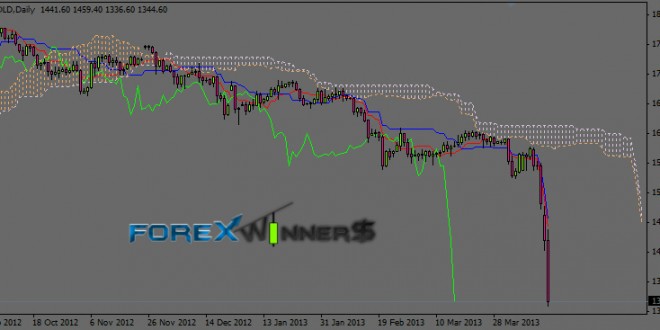Daily chart for Gold.
Gold has fallen to its lowest level in two years, on weak Chinese economic data, and receding fears about the chance of higher inflation in the US.
The price of the precious metal was down 9.2% to $1,395 an ounce.
The weaker than expected growth in China’s economy also sparked a wider fall in commodity prices.
Oil prices fell to four-month lows, with Brent crude down $2.29 to $100.75 a barrel. The price of copper and aluminium were also sharply lower.
Copper fell to its lowest level in a year and a half at $7,085 a tonne, and aluminium sank to a three-and-a-half year low.
The declines followed after China said overnight that its economy expanded by 7.7% in the first quarter of 2013, lower than forecasts and below the pace of growth of recent years.
Analysts said a key factor in gold’s fall was the expectation that the US central bank, the Federal Reserve, will tighten monetary policy by stopping its quantitative easing (QE) programme.
This means that the rate of US inflation is likely to fall, meaning investors have less reason to hold gold to avoid a corresponding decline in the value of cash investments.
Cyprus’s announcement last week that it was planning to sell most of its gold reserves has also had an impact on the fall in the price of gold.
Some analysts fear that other weak eurozone economies, such as Italy and Spain, will follow Cyprus’s lead and sell some of their gold stocks, adding further supply to weakening demand.
Dominic Schnider, an analyst at UBS Wealth Management, said it might not have been the eurozone that triggered the mass flight out of gold: “What we now see is panic selling, perhaps triggered by the Fed’s stimulus view. The Fed has given the signal that there’s a possibility to reduce QE and that took a lot of trust out of gold.
“And people recognise that an environment where you have no inflation is a powerful driver to get out of the metal.”
Sources :
bbc.co.uk
Foxnews.com
reuters.com
 Forex Winners | Free Download Downlod free trading sysrems , indicators and forex E-books
Forex Winners | Free Download Downlod free trading sysrems , indicators and forex E-books

